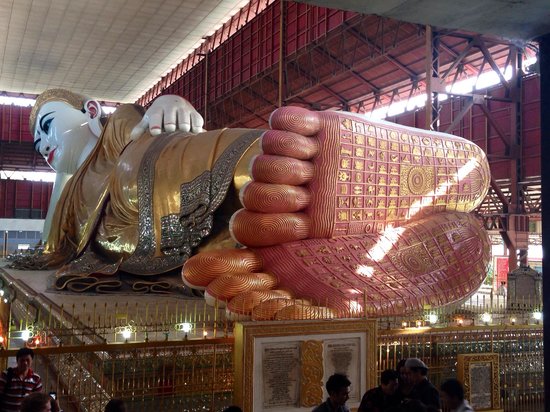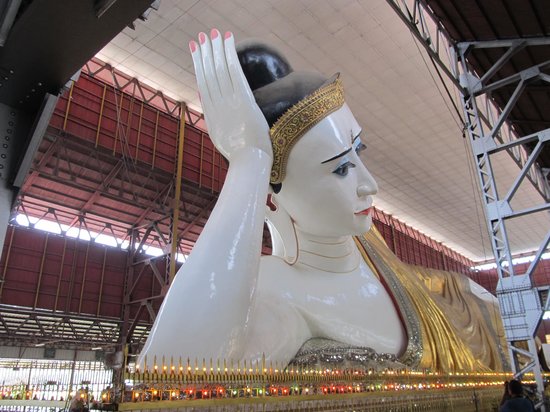 |
| Foot of the massive mountain-sized Buddha in Leshan, China (stephen-t.com) |
 |
| The Buddha's feet at Chaukhtatgyi Paya Pagoda in Rangoon, Burma (courtesy of TripAdvisor). |
 |
| The Buddha in Burma (Bas1953/flickr) |
This position, called the "lion's posture" (sīhaseyya, which helps overcome the hindrance to meditation called sloth and torpor) -- leaning on the right propped up on the right elbow head held in palm with a pillow or rolled up robe under one's breast, with one leg on top of the other -- is restful and keeps one from falling asleep.
It also, in architectural terms, exposes the soles of the feet. So a great deal of markings have been placed on them trying to depict the miraculous signs on his body. The various Marks of a Great Man, called the lakkhana, comes from an ancient Vedic teaching about cakkavatti or chakravartins, world-monarchs, which is what Prince Siddhartha was born capable of becoming (due to past karma) if he had not chosen to become a world-teacher.
 |
| The Buddha's golden feet, Thailand (Salvan Joachim/Salvanize/flickr.com) |
.
 |
| The Buddha's feet (courtesy of TripAdvisor). |
- Images of the Buddha's footprint symbolize the Buddha's presence and teaching, known as the Dharma. They emphasize the fact that he was born a mortal human being who walked this Earth. It also reminds us that a "spiritual" Buddhist life is about maintaining our feet on the ground. While we aspire and play (work) toward "transcendence," going beyond all ignorance and suffering, we do not lose awareness of the physical (the sensual and fine-material spheres) and this plane of existence. At the same time, disembodied feet suggest the Buddha's absence, the human personality that was manifested in his final life, and by extension, his non-attachment or letting go. The Buddha's footprint, Buddhapada, is one of the aniconic symbols of Buddhism, which is to say, it does not attempt to be a true likeness of the teacher. For years after the Buddha's nirvana -- in keeping with his instructions -- his physical form and likeness were kept out of the teaching. Instead, images like the Dharma wheel, lion, the Bodhi tree, alms bowl, saffron robe, and footprint served to in his place.
These countries (janapadas, "clan footholds") are called "ancient India" only for convenience, for there was no such thing as "India." The Sanskrit language, the Brahmanism, the original concept of thousands of castes, the sacred knowledge texts (Vedas) all came not from what we call India but from the more ancient Indus Valley Civilization, which is right next door to Afghanistan in the Himalayan foothills.
What about his feet? At least 30 of the "marks" or "signs," 32 major ones and 80 minor ones, relate to his feet. We list them below. It is because of this peculiar feature of Indian reverence of saints's feet that Jesus (known as Issa in India and Isa in Islam) and his feet are mentioned.
There is a famous song, and Jesus's tomb -- not the temporary one in Palestine/Jerusalem called the Holy Sepulchre or the Garden Tomb but the permanent one in Kashmir called Rozabal (see the original work of Nicolas Notovich and contemporary scholarship by Holger Kersten) -- is marked with footprints, which is unheard of in Islam and Judaism but perfectly consistent with Buddhism, Brahmanism/Vedic Hinduism, and Jainism.
There is a famous song, and Jesus's tomb -- not the temporary one in Palestine/Jerusalem called the Holy Sepulchre or the Garden Tomb but the permanent one in Kashmir called Rozabal (see the original work of Nicolas Notovich and contemporary scholarship by Holger Kersten) -- is marked with footprints, which is unheard of in Islam and Judaism but perfectly consistent with Buddhism, Brahmanism/Vedic Hinduism, and Jainism.
Level feet
Images of the soles of the Buddha's feet - 1,000-spoked wheel sign on feet
- Pliant hands and feet
- Toes and fingers finely webbed
- Full-sized heels
- Arched insteps
- Golden-hued body
- Ten-foot aura
- Soft, smooth skin
- Soles, palms, shoulders, and crown of head well-rounded
- He has beautiful fingers and toes.
- He has well-proportioned fingers and toes.
- He has tube-shaped fingers and toes.
- His fingernails and toenails have a rosy tint.
- His fingernails and toenails are slightly upturned at the tip.
- His fingernails and toenails are smooth and rounded without ridges.
- His ankles and wrists are rounded and undented.
- His feet are of equal length.
- He has a beautiful gait, like that of a king-elephant.
- He has a stately gait, like that of a king-lion.
- He has a beautiful gait, like that of a swan.
- He has a majestic gait, like that of a royal ox.
- His right foot leads when walking.
- He has the strength of 1,000 crore elephants or 100,000 crore of ordinary men.
- His skin is fine throughout his body.
- His whole body has abundant signs of good fortune.
- His body is always radiant.
- His body is always refreshed like a lotus flower.
- His body is exquisitely sensitive to touch.
- His body has the scent of sandalwood.
 |
| Front view of the Buddha's in lion's pose (courtesy of TripAdvisor.com) |
The Buddha statue at the Burmese temple known as Chauk Htat Gyi Pagoda is very impressive. It is 65 meters long and 16 meters high and wearing a golden robe, another fact relating to the day of his final nirvana. (See Last Days of the Buddha, based on the "Great Final-Nirvana Sutra," DN 16).
That robe was a fine gift from Pukkusa of the Malla clan. He said to a certain person: "Bring me at once, friend, two sets of golden-colored robes, burnished and ready for wear!" The person answered him: "So be it, sir!" And when the robes were brought, Pukkusa of the Malla clan offered them to the Buddha, saying: "May the Blessed One, O venerable sir, out of compassion, accept this from me." And the Buddha said: "Robe me in one, Pukkusa, and in the other robe Ananda" (DN 16, 44-45). Ananda was the Buddha's cousin and long-time attendant, whose memory was such that he remembered all of the sutras and recited them at the First Council so that we have them today.
The right arm of the Buddha is supporting the back of his head. The statue is from the texts: fair and golden complexion, blue eyes, red lips, golden robe, pink finger nails. The soles of the feet contain 108 segments with images representing the various auspicious characteristics or lakkhanas of the Buddha. Buddhists pay respect with fragrant incense sticks and flower offerings.
Around the statue there are shrines, one for each of the eight days of the week in Asian astrology (with Wednesday split into two days). Local people go to the shrine belonging to the day of their birth.




















































































































































































































































No comments:
Post a Comment